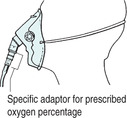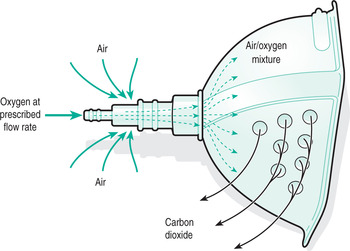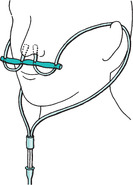Learning outcomes
By the end of this section, you should know how to:
▪ prepare the patient for this nursing practice
▪ collect and prepare the equipment
▪ administer oxygen therapy at home or in an institutional setting.
Background knowledge required
Revision of the anatomy and physiology of the cardiopulmonary system, with special reference to the exchange of gases and the mechanism of respiration
Revision of the dangers of the use of oxygen
Review of local policies and procedures regarding fire precautions and oxygen therapy, in both institutional and community care.
Indications and rationale for oxygen therapy
Except in emergency situations, oxygen therapy will be prescribed by a medical practitioner, who will specify both the percentage of oxygen and the method of administration. The administration of oxygen is one of the specific medical treatments: patients will have individually assessed requirements related to their particular medical problem (British National Formulary 2006).
Oxygen therapy can be administered in the patient’s own home under the care of the community nurse or in an institutional setting, but the principles underlying this nursing practice remain the same wherever it takes place. At home, the oxygen cylinder and its associated equipment will be delivered regularly to the patient’s home from a central supply, depending on the policy of the individual health board, as prescribed and ordered by the general practitioner. Alternatively, oxygen may be administered via an oxygen concentrator, which is an effective and economical way to deliver therapy to a patient who requires long-term intervention (British National Formulary 2006). Guidelines on the monitoring of patients outside institutional settings is provided by the Royal College of Physicians (1999) and NICE in the COPD national guideline (National Institute for Clinical Excellence 2004).
 Equipment
Equipment1. Oxygen supply, e.g. piped oxygen or oxygen cylinder
2. Oxygen concentrator (for use in the community)
3. Reduction gauge as required
4. Flow meter
5. Oxygen mask or nasal cannulae as appropriate
6. Oxygen tubing
7. Humidifier as appropriate
8. ‘No Smoking’ signs
9. Receptacle for soiled disposable items.
Oxygen masks
Oxygen masks (Fig. 29.1) are designed to provide an accurate percentage of oxygen by entraining an appropriate amount of air for a specific flow rate of oxygen (Francis 2006). Instructions are available for each type of mask and these should be used accordingly (Francis 2006).
 |
| FIGURE 29.1Oxygen therapy: mask in position |
They can be classified according to their performance, which can be fixed or variable. Fixed-performance masks provide a concentration of oxygen that does not vary with the patient’s rate and depth of breathing. An example of these is the Venturi masks (Fig. 29.2), which, through the addition of a colour-coded attachment to the jets, can provide a variety of oxygen concentrations from 24 to 60%. Venturi masks are suitable for use with patients who have chronic obstructive pulmonary disease (COPD).
 |
| FIGURE 29.2Venturi fixed-performance oxygen maskFrom Brooker & Nicol 2003, with permission |
Variable performance masks, such as the Hudson, can be attached to a reservoir bag. Used alone they provide an oxygen concentration, depending on oxygen flow rate and the patient’s respiratory rate and depth, of 30–60%. If the mask is attached to a reservoir bag, which does not permit rebreathing, and oxygen at 12L min−1, oxygen concentrations of 95% can be delivered (Boumphrey et al 2003, Francis 2006) The performance of nasal cannulae is also variable with respiratory effort. These are light plastic tubes inserted into each nostril and shaped to fit over the ears to maintain their position (Fig. 29.3). Patients find them more comfortable and less claustrophobic than a conventional mask. However, they are not suitable for all patients as they should only be used with an oxygen flow rate of 4L min−1 or less and deliver oxygen concentrations of between 22 and 35% (Francis 2006).
 |
| FIGURE 29.3Oxygen therapy: nasal cannulae in position |
Oxygen may be delivered directly into an endotracheal tube or tracheostomy tube via wide corrugated tubing and a T-piece. Adequate humidification is essential here.
Oxygen tents
These are used mainly in paediatrics, when babies and young children would not tolerate masks. The danger of fire is increased further using this method, because of the larger area of concentrated oxygen within the oxygen tent, and the difficulty of confining the gas to a small area when nursing the patient.
Emergency situations
Stay updated, free articles. Join our Telegram channel

Full access? Get Clinical Tree


